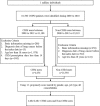Conventional Western Treatment Combined With Chinese Herbal Medicine Alleviates the Progressive Risk of Lung Cancer in Patients With Chronic Obstructive Pulmonary Disease: A Nationwide Retrospective Cohort Study
- PMID: 31572178
- PMCID: PMC6753872
- DOI: 10.3389/fphar.2019.00987
Conventional Western Treatment Combined With Chinese Herbal Medicine Alleviates the Progressive Risk of Lung Cancer in Patients With Chronic Obstructive Pulmonary Disease: A Nationwide Retrospective Cohort Study
Abstract
Background and purpose: Lung cancer has high global incidence and mortality rates. Chronic obstructive pulmonary disease (COPD) is strongly associated with lung cancer and is an independent risk factor for lung cancer with or without smoking. Chinese herbal medicines (CHMs) are used to treat COPD. This study sought to determine whether CHM treatment effectively decreases the incidence of lung cancer in COPD patients receiving conventional Western medical treatment. Methods: Records obtained from the National Health Insurance Research Database (NHIRD) were used to identify 81,780 adults aged ≥18 years newly diagnosed with COPD in Taiwan between 2000 and 2010. Among them, 11,180 received CHMs after COPD diagnosis and 23,319 did not (non-CHM). After excluding patients with missing basic demographic information, each group consisted of 2,682 patients. Statistical methods analyzed the baseline characteristics for both groups and we performed a Cox proportional hazard regression analysis to examine the incidence of lung cancer. The cumulative incidence of lung cancer in COPD patients with or without CHM treatment was calculated by the Kaplan-Meier method. The association between herbs and formulas was examined by NodeXL to perform a network analysis of CHM. Results: COPD patients using CHM had a lower risk for lung cancer (adjusted hazards ratio [aHR] = 0.36, 95% confidence interval [CI] = 0.24-0.53, p < 0.001). Older age was associated with a higher risk of lung cancer: patients aged 40-59 years (aHR = 5.32, 95% CI = 2.19-12.94, p < 0.001) and those aged ≥60 years (aHR = 16.75, 95% CI = 7.54-37.23, p < 0.001) were at significantly greater risk compared with patients aged 18-39 years. CHM use was associated with a trend for a lower cumulative incidence of lung cancer compared with non-CHM use (p < 0.001). Among the 10 most commonly used single herbs and formulas used to decrease the risk of lung cancer in COPD patients, Fritillariae thunbergii was the most commonly used single herb and Xiao Qing Long Tang the most commonly used formula. Conclusion: The findings from this nationwide retrospective cohort study indicate that CHM as adjunctive therapy in COPD treatment regimens may reduce the risk of lung cancer in this vulnerable patient population.
Keywords: Chinese herbal medicine; chronic obstructive pulmonary disease; lung cancer; retrospective cohort study; traditional Chinese medicine.
Copyright © 2019 Lin, Chen, Su, Lin, Lin and Huang.
Figures




References
LinkOut - more resources
Full Text Sources

